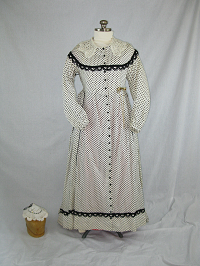1862-1865
The Civil War caused an expansion of industrial developments especially in shoes and textiles. New methods of merchandising such as men’s ready made clothing brought about a more rapid change in fashion. The gored skirt replaced the many gathers and the silhouette became more angular. The skirt hem which had been even, now ended in trains for daytime as well as for evening. (No. In 1862-63, the Black and White Mania struck.) Nellie is wearing a spotted cotton summer day dress. By the end of 1863 the waist line had become quite high and on some gowns was nonexistent. Called “En Princesse” this gown’s bodice and skirt is one piece. The dropped shoulder line has returned to its proper place and the satin sleeve is shaped at the elbow. To hang well over the new shaped crinoline, the skirt’s fullness is box pleated into the seams. Pockets are back but have been attached to the front seam. The handerkerchief is in the pocket not in the hand. Hairdos became more important than bonnets. Chignons, made from added hair, were introduced in Paris, and became popular in the US for indoor wear. Over these were worn crocheted or knitted and beribboned caps.
Gowns in the fashion magazine illustrations were highly trimmed but Mr. Godey stated it was up to each woman to decide what and how much trimming suited her and her station in life. This gown has a looped braid to form a yoke on the bodice and edge the hem. Piping was used on the skirt seams to accent the new triangular shape. But now instead of sewing it in the seams it is sewn on the top. The 24 buttons down the front are just decorations as the gown is closed with hooks and eyes. To keep them from becoming unhooked they are sewn on alternatingly. The high neckline has a hand crocheted collar.
Fashion permitted a woman to loop up the trained skirt while walking in dirty streets. This necessitated a pretty petticoat. Bright colored merinos with scarlet were preferred, and were made possible by the discovery of aniline dyes. “Caged” petticoats were much reduced at the top but they became larger on the bottom. The gentlemen enjoyed the flatter front. Some hoops had concealed strings that when pulled made it possible to ascend stairs. The crinoline was worn by all classes. It caused havoc in factories, especially where they made china and glass, as the large skirts swept objects off of shelves. In strong winds, wearers could be blown off their feet. The more serious danger was from fireplaces. The wire frame made it impossible to wrap a burning skirt in order to smother the flame.
Tight lacing persisted but was less extreme because the large skirts gave the illusion of a small waist. Corsets were now made by joining separate pieces instead of adding gussets. White was most elegant, but gray, putty, red, and black more serviceable. Drawers consisted of two separate sections sewn on a waistband. They were therefore open below the waist and overlapped in the back.
Stocking colors varied from white to black. The 1860s saw black stockings and the beginning of modern shoes. Manufactured shoes could be bought in stores, in pairs, one for the right and one for the left foot, for the first time. The popular boot was tightly laced up the side.
This outfit was made by Nellie Wright.
Click photo for detailed views.


